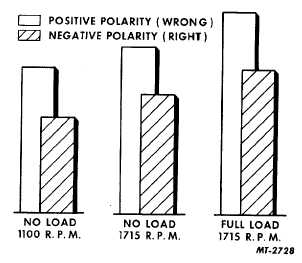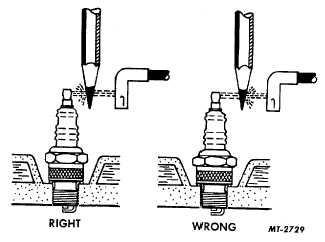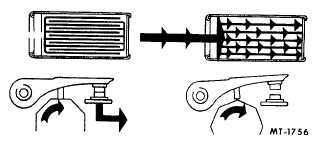|
| |
TRUCK SERVICE MANUAL
TM 5-4210-230-14&P-1
ELECTRICAL
Fig. 5 Chart Showing Extra Voltage Required When Polarity Is
Reversed
For a time, the engine may run fine with coil polarity
reversed--until the spark plugs have been in use for some
time. Then, the driver may encounter hard starting or
misfiring under load, as the amount of voltage required to fire
the spark plugs under these conditions is higher than at any
other time.
In view of the above, it is very important that coil
polarity should always be such that negative current is
supplied to the spark plug terminals.
CHECKING FOR REVERSED POLARITY
A quick and easy method in checking for reversed
polarity is the use of an ordinary wooden pencil, Fig. 6. Using
the wooden pencil-check method, remove an ignition cable
from any one of the spark plugs. Then, place the graphite tip
of the pencil between the spark plug terminal and the cable
and observe the spark as it jumps across the gap. If you
notice the spark flaring or having an orange tinge on the spark
plug side of the pencil, polarity is correct. If it flares or has a
tinge on the cable side, polarity is reversed (be sure to use a
wooden pencil when making this check or an uncomfortable
shock may be received from the spark plugs). NOTE: The
above check is used particularly on those coils not having any
markings on the coil terminals. All coils recommended and
used by the International Harvester Company are properly
marked.
NOTE: When checking for reversed polarity, always be
certain that the spark plugs are correctly gapped and in good
condition.
Fig. 6 Method of Checking for Reversed Polarity
CONDENSERS
The condenser which is mounted inside ignition system
distributor prevents arcing of distributor points when points
begin to open by providing a place for current to flow until
points are safely separated. This requires special insulating
between the two foil sheets which store current flow and bring
it to a quick controlled stop, Fig. 7.
Fig. 7 Action of Current on Condenser
Ignition failures of a few years back were often the
result of condenser breakdown. Subsequent investigation
proved that internal moisture was responsible. With the
adoption of pre-dried insulating paper and hermetic sealing in
recent years, condenser breakdown has been practically
eliminated. Condenser can is crimped against outer gasket
and this compresses a spring at bottom of can with 40 pounds
pressure to effectively seal inner and outer gasket surfaces,
Fig. 8. Pressure feature provides vibration-free connections
which lessen the possibility of high series resistance in
condenser assembly.
CTS-2013-E Page 6
PRINTED IN UNITED STATES OF AMERICA
|



